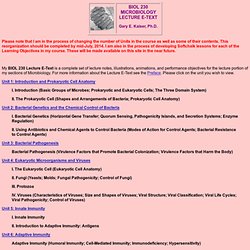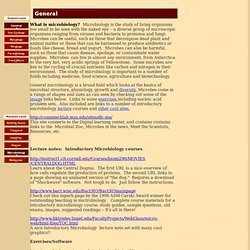

MICROBIOLOGY 101/102 HOME PAGE. Keep Posted Micro 102 was designed as a 3 credit, distant learning, Internet-based (virtual) course that fulfills the lecture portion for a WSU Biology General Educational Requirement, as well as the requirements for the WSU Nursing, Human Nutrition General Dietetics, Physical Therapy and the Plant Pathology Degrees; it is also meets the lecture requirement for most certified health-related programs such as Physician's Assistant. Under modified conditions, on-campus WSU students may also take Micro 102. Micro 102 consists of the material in the NetText101 chapters, and in the indicated URLs.
Some required readings may be required. If you are planning on using Micro 102 as credit towards a degree, check with the institution/department from which you expect to obtain the degree before registering to insure that you will for this course towards your degree. On-campus students however, are required to take the exams during the same week that the Micro 101 students take theirs. PO Box 645220. Food Safety. Courses and resources for farmers, processors, and the food service industry to ensure safe food from farm to table.

USDA Food Safety Tips for Areas Affected by Snow Storms February 12, 2014 With the continuous parade of winter storms hitting the U.S., USDA has released an information sheet titled Food Safety Tips for Areas Affected by Snow Storms. Don't overlook safe turkey-handling practices for a happy holiday November 25, 2013 UNIVERSITY PARK, Pa. -- Thanksgiving is a time for sharing: good food, family time, friendship and memories. Research minimizes effects of federal produce standards on mushroom industry September 23, 2013 UNIVERSITY PARK, Pa. -- Strict requirements on the use of animal manures in fresh produce production imposed by the new federal food-safety law threatened to adversely impact the mushroom industry, which relies on horse and poultry manure for a specialized growth substrate.
Extension specialist: Carefully follow instructions to preserve foods safely August 29, 2013. A look at all things small. BioL 230 Lecture Guide. Please note that I am in the process of changing the number of Units in the course as well as some of their contents.

This reorganization should be completed by mid-July, 2014. I am also in the process of developing Softchalk lessons for each of the Learning Objectives in my course. These will be made available on this site in the near future. My BIOL 230 Lecture E-Text is a complete set of lecture notes, illustrations, animations, and performance objectives for the lecture portion of my sections of Microbiology. For more information about the Lecture E-Text see the Preface.
Unit 1: Introduction and Prokaryotic Cell Anatomy I. Unit 2: Bacterial Genetics and the Chemical Control of Bacteria I. Unit 3: Bacterial Pathogenesis Bacterial Pathogenesis (Virulence Factors that Promote Bacterial Colonization; Virulence Factors that Harm the Body) Unit 4: Eukaryotic Microorganisms and Viruses I. Unit 5: Innate Immunity I. Unit 6: Adaptive Immunity Unit 7: Microbial Genetics and Microbial Metabolism I. General. What is microbiology?

Microbiology is the study of living organisms too small to be seen with the naked eye - a diverse group of microscopic organisms ranging from viruses and bacteria to protozoa and fungi. Microbes can be useful, such as those that decompose dead plant and animal matter or those that can be harnessed to produce antibiotics or foods like cheese, bread and yogurt. Microbes can also be harmful, such as those that cause disease, spoilage, or contaminate water supplies. Microbes can live in almost any environment, from Antarctica to the very hot, very acidic springs of Yellowstone.
Some microbes are key to the cycling of crucial nutrients like carbon and nitrogen in their environment. General microbiology is a broad field which looks at the basics of microbial structure, physiology, growth and diversity. Site connects to the Digital learning center, and contains contains links to the Microbial Zoo, Microbes in the news, Meet the Scientists, Resources, etc. (Tree of Life)